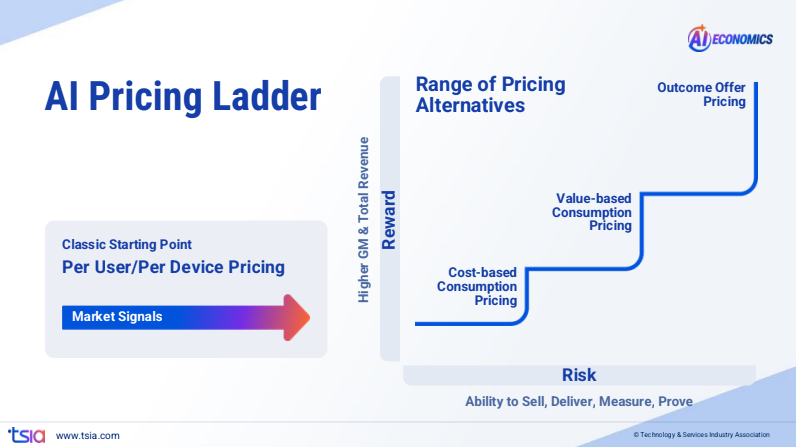In his keynote, The Race to Profitability in AI Economics™, TSIA Executive Director and EVP Thomas Lah explored how AI isn’t just transforming products—it’s rewriting the economics of the entire technology industry. As Lah told the audience, “This isn’t rainbows and unicorns. This is more like the coming of the Borg. Resistance is futile.”
The message was clear: AI disruption isn’t coming—it’s here. And if you want to win in this new economy, you need to understand how value, pricing, and services are being redefined in real time.
Your Key Takeaways
- AI disruption is permanent—and profitability must follow. Most AI business models today are unprofitable. Lack of profitability is simply an unsustainable business model.
- Pricing is your most powerful transformation lever. You can’t rely on cost-plus or consumption pricing models. Value-based and outcome pricing are where sustainable profit lives.
- Services are your competitive advantage. AI creates an enormous “last mile” opportunity for services that deliver, realize, and manage value over time.
AI Disruption Isn’t Going Away
Lah opened with a striking, but straightforward insight: the AI market looks a lot like the dot-com and SaaS eras—massive excitement, but little profitability. When TSIA created the AI 20 Index, a list of 20 publicly traded AI-focused companies, the results were “stunning—not in a good way.”
While the TSIA 50 companies average 19% operating income, and cloud companies sit around 3%, the AI 20 posted –29%.
The parallels to the late 90s are striking. In 1999, 68% of advertisers said the internet couldn’t prove ROI. Two decades later, no business could function without it. Lah’s point? The same pattern will unfold for AI—just much faster.
AI will eliminate jobs, restructure service models, and decouple revenue growth from headcount growth. “The game plan in every boardroom,” Lah said, “is to keep growing revenue with flat or fewer people.” The companies that thrive will be those ready to adapt their economics to this new reality.
A New Competitive Landscape for Tech
For decades, technology business models evolved in waves:
- Hardware fell to software.
- Software yielded to services.
- On-prem gave way to cloud and XaaS.
Now, AI is rewriting the rules again.
In this new landscape, AI engines are eating the apps—companies like OpenAI and Google aren’t stopping at infrastructure. TSIA predicts they will be building enterprise-class applications to climb the value chain and capture more profit. Meanwhile, outcomes-based consumption—the next phase of pricing evolution—is where customers pay for business value rather than usage.
Lah warned that companies can’t keep spending billions of dollars without a path to profit. The market, he explained, is already rewarding those who connect AI to measurable outcomes.
That’s why organizations like Palantir—offering complete stacks that blend technology, project-based services, and outcome-based offers—are becoming some of the most profitable and highly valued companies in the world.
Climbing the AI Pricing Ladder
According to Lah, there are four main ways to price AI capabilities today:
- User-based pricing: Price per seat or license.
- Cost-based consumption: Price per unit or API call.
- Value-based consumption: Higher price for capabilities that deliver higher value.
- Outcome-based pricing: Price based on the actual business results delivered.

This “AI Pricing Ladder,” as Lah calls it, is the roadmap for profitability. But most companies are still stuck at the bottom.

“Everybody knows that dog is not going to hunt anymore,” Lah said of user-based pricing models. “And if you stay in a cost-plus mentality with consumption-based pricing, you are going to be sad.”
The ultimate leap is to outcome-based pricing, where technology providers share risk and reward. In AI Economics™, your success isn’t measured by how much your customer uses your product—it’s measured by the tangible business value they achieve from it.
Related: Pricing-Led Transformation Under AI Economics™
Why Services Are the New Profit Engine
If pricing defines how you make money, services determine whether you keep it. Lah made it clear: “It is clear to us there’s no way you have a profitable tech business model in the world of AI, unless you have a robust service capability.”
That’s because enterprise customers are struggling with what the industry calls “the last mile problem”—the gap between adopting AI and realizing its value.
To close that gap, companies need to understand three core drivers of services:
- Value environment: Helping customers prepare their data, infrastructure, and governance for AI.
- Value realization: Enabling customers to achieve measurable business outcomes.
- Value management: Continuously tuning models as data and workflows evolve.
These drivers are unavoidable. They are the fundamental influencers of new services that lead to profitable AI business models.

As Lah noted, even the most well-funded AI startups can’t snap their fingers and build a $35-billion services business. Incumbents, however, already have global service capabilities and trusted customer relationships—two massive advantages. The challenge? They must retool those services for an AI-driven world.
Related: Why Advanced Services Are Defining the Next Era of AI
Pricing-Led Transformation: The Lesson From iTunes
Lah ended his keynote where he began—on a morning run, with a playlist that reminded him of how digital music transformed an industry.
When streaming replaced albums, artists were forced to find new revenue models. Touring went from break-even to a billion-dollar enterprise. Why? Because pricing changed—and so did the business model.
That same kind of pricing-led transformation is now happening in AI Economics™:
- Subscription pricing defined the SaaS era.
- Outcome pricing will define the AI era.
As Lah explained, this shift doesn’t just affect revenue—it reshapes financial models, operating structures, and service portfolios. For AI to be profitable, pricing must move first.
The Three Races to Profitability in AI Economics™
Lah closed with a challenge for every tech executive: AI’s impact won’t unfold over 20 years—it’s happening right now.
There are three races you must run simultaneously:
- Decouple revenue growth from headcount growth: AI must drive efficiency, not just innovation.
- Climb the pricing ladder to value: Move from cost-plus or consumption to outcome-based pricing.
- Retool your services engine: Build new offers and operating models that turn AI into recurring, measurable business value.
“This isn’t the end of services,” Lah concluded. “This is the era of services.”
Related: The AI Services Era: Why Services Are Now Your Greatest Advantage
Frequently Asked Questions
What is AI Economics™?
AI Economics™ refers to how artificial intelligence is reshaping the way technology companies generate, deliver, and measure value. It examines the relationship between automation, labor, infrastructure costs, and profitability.
Why are so many AI companies unprofitable right now?
Most AI companies are still in the “capability” phase—building tools and models without transparent pricing or outcome strategies. Until they connect their technologies to measurable business value delivered through services, profits will lag.
How can incumbents compete with AI-native startups?
Incumbents already have two advantages: trust and services. Enterprise customers prefer to work with providers who know their business and can deliver results. By leveraging your service portfolio and shifting to value-based pricing, you can outpace AI-native competitors.
Smart Tip: Embrace Data-Driven Decision Making
Making smart, informed decisions is more crucial than ever. Leveraging TSIA’s in-depth insights and data-driven frameworks can help you navigate industry shifts confidently. Remember, in a world driven by artificial intelligence and digital transformation, the key to sustained success lies in making strategic decisions informed by reliable data, ensuring your role as a leader in your industry.





.png)






